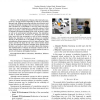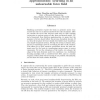64 search results - page 9 / 13 » A model of force and impedance in human arm movements |
HAPTICS
2010
IEEE
13 years 5 months ago
2010
IEEE
In haptic length perception biases occur that have previously been shown to depend on stimulus orientation and stimulus length. We propose that these biases arise from the muscular...
ACHI
2010
IEEE
14 years 2 months ago
2010
IEEE
Abstract—The development of human-robot interaction scenarios is a strongly situation-dependent as well as an extremely dynamic task. Humans interacting with the robot directly r...
NIPS
2001
13 years 9 months ago
2001
Reaching movements require the brain to generate motor commands that rely on an internal model of the task's dynamics. Here we consider the errors that subjects make early in...
NIPS
2008
13 years 9 months ago
2008
Motor primitives or motion templates have become an important concept for both modeling human motor control as well as generating robot behaviors using imitation learning. Recent ...
AMDO
2008
Springer
13 years 9 months ago
2008
Springer
Abstract. In this paper we present our work on markerless model-based 3D human motion capture using multiple cameras. We use an industry proven anthropometric human model that was ...


